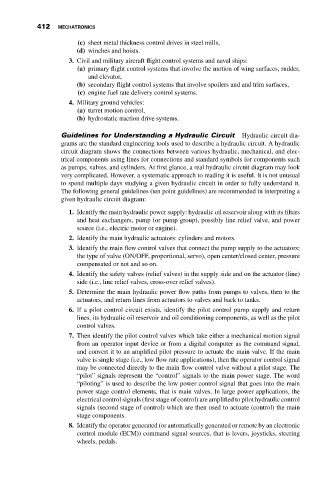Page 426 - Mechatronics with Experiments
P. 426
JWST499-Cetinkunt
JWST499-c07
412 MECHATRONICS Printer: Yet to Come October 9, 2014 8:41 254mm×178mm
(c) sheet metal thickness control drives in steel mills,
(d) winches and hoists.
3. Civil and military aircraft flight control systems and naval ships:
(a) primary flight control systems that involve the motion of wing surfaces, rudder,
and elevator,
(b) secondary flight control systems that involve spoilers and and trim surfaces,
(c) engine fuel rate delivery control systems.
4. Military ground vehicles:
(a) turret motion control,
(b) hydrostatic traction drive systems.
Guidelines for Understanding a Hydraulic Circuit Hydraulic circuit dia-
grams are the standard engineering tools used to describe a hydraulic circuit. A hydraulic
circuit diagram shows the connections between various hydraulic, mechanical, and elec-
trical components using lines for connections and standard symbols for components such
as pumps, valves, and cylinders. At first glance, a real hydraulic circuit diagram may look
very complicated. However, a systematic approach to reading it is useful. It is not unusual
to spend multiple days studying a given hydraulic circuit in order to fully understand it.
The following general guidelines (ten point guidelines) are recommended in interpreting a
given hydraulic circuit diagram:
1. Identify the main hydraulic power supply: hydraulic oil reservoir along with its filters
and heat exchangers, pump (or pump group), possibly line relief valve, and power
source (i.e., electric motor or engine).
2. Identify the main hydraulic actuators: cylinders and motors.
3. Identify the main flow control valves that connect the pump supply to the actuators;
the type of valve (ON/OFF, proportional, servo), open center/closed center, pressure
compensated or not and so on.
4. Identify the safety valves (relief valves) in the supply side and on the actuator (line)
side (i.e., line relief valves, cross-over relief valves).
5. Determine the main hydraulic power flow paths from pumps to valves, then to the
actuators, and return lines from actuators to valves and back to tanks.
6. If a pilot control circuit exists, identify the pilot control pump supply and return
lines, its hydraulic oil reservoir and oil conditioning components, as well as the pilot
control valves.
7. Then identify the pilot control valves which take either a mechanical motion signal
from an operator input device or from a digital computer as the command signal,
and convert it to an amplified pilot pressure to actuate the main valve. If the main
valve is single stage (i.e., low flow rate applications), then the operator control signal
may be connected directly to the main flow control valve without a pilot stage. The
“pilot” signals represent the “control” signals to the main power stage. The word
“piloting” is used to describe the low power control signal that goes into the main
power stage control elements, that is main valves. In large power applications, the
electrical control signals (first stage of control) are amplified to pilot hydraulic control
signals (second stage of control) which are then used to actuate (control) the main
stage components.
8. Identify the operator generated (or automatically generated or remote by an electronic
control module (ECM)) command signal sources, that is levers, joysticks, steering
wheels, pedals.

